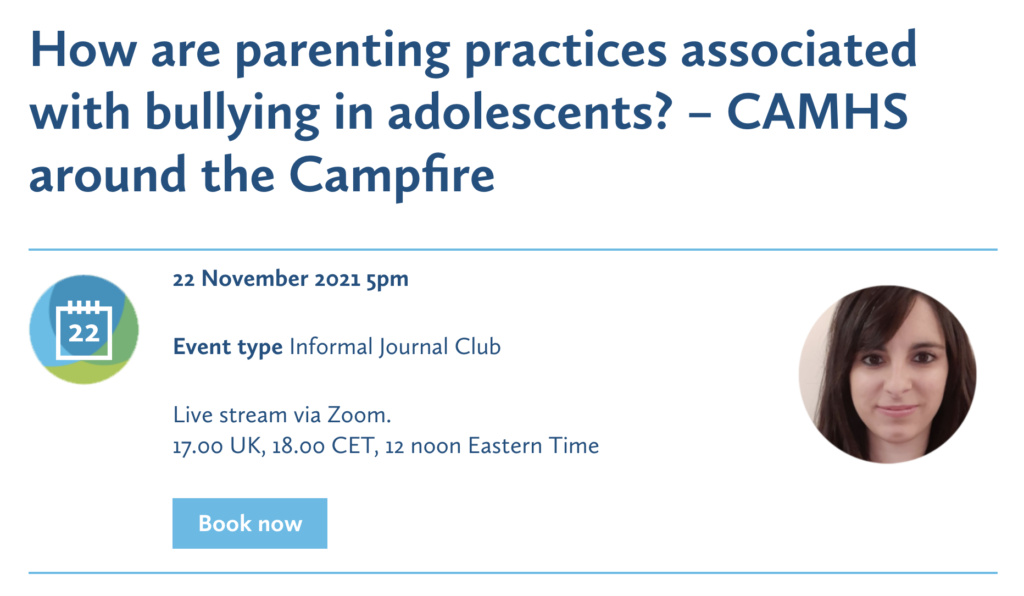
Bullying is common and hugely damaging to young people and their parents. It is a significant risk factor for depression, anxiety, self-harm and many other adverse outcomes. Parents can feel powerless to intervene in what is often seen as a school-based issue. Is there anything parents can do to help?
One problem is that “parenting” is difficult to assess. Previous research has tended to focus on how “parenting styles” are linked with bullying involvement. This may not be all that helpful. Perhaps it is better to think in terms of “parenting practices” (specific behaviours, or types of behaviour that are easily identifiable and consequently, modifiable). These might be easier to change than a “style”.
Ineffective parenting practices have been related to child and adolescent behavioural problems (Zlomke et al., 2013). Conversely more efficient parenting practices are positively related to a higher quality of life in different areas including school attainment and friendships (Escribano, Aniorte, & Orgiles, 2013). However, Zych, Farrington, Llorent, Ribeaud, and Eisner (2020) found that there was no relationship between positive parenting and traditional bullying involvement.
So this new study (Pascual-Sanchezet al, 2021) asked adolescents themselves about their parents’ behaviours, and their experience of bullying. The aim was to assess associations between specific parenting practices and involvement in bullying.
The researchers set out to investigate two hypotheses:
- Low scores in effective parenting practices will be associated with both cyberbullying and traditional bullying involvement.
- High scores in ineffective parenting practices will be associated with both cyberbullying and traditional bullying perpetration.

Parenting practices may be easier to change than parenting styles.
Methods
They invited 49 secondary schools in London to take part. Eight responded, from which four schools were recruited. 2,218 of the 2,764 eligible pupils took part. Pupils filled out a questionnaire to provide all of the information about parenting practices, and their experience of bullying.
The survey instrument recorded the following information:
- Demographic information
- Cyber and traditional bullying status, using the Olweus Bully/Victim Questionnaire, adapted for cyberbullying. Thresholds were used to characterise to three bullying “roles”:
- “Victims” = 2-3 times per month
- “Bullies” = any
- “Bully+victims” = both
- Parenting practices, using the Alabama Parenting Questionnaire (Frick, 1991), using the following dimensions:
- Positive Parenting
- Parenting Involvement
- Poor Monitoring
- Inconsistent Discipline
The researchers constructed a regression model to examine the associations between these items.
Data missing more than one item were omitted from the analysis.
Results
The respondents were ethnically and demographically diverse. Weak associations were found between some parenting practices and some experiences of bullying:
- Low scores on Positive Parenting were associated with involvement with all bullying roles: the lower the positive parenting, the higher the risk
- Inconsistent Discipline was associated with being a cyberbully: the higher the inconsistency, the higher the risk
- Poor Monitoring was associated with being a “traditional” bully or bully+victim: the worse the monitoring, the higher the risk.
This table shows which factors showed a statistically significant association with bullying involvement, and how strongly. Those in italics are the ones the researchers were most interested in.
| Bullying role→ | Being a victim | Being a bully | Being a bully+victim |
|||
| Effect size↓ | Cyber | Trad | Cyber | Trad | Cyber | Trad |
| was strongly associated with | Gender
Ethnicity* |
Gender
Ethnicity |
Ethnicity | Ethnicity
Gender School |
|
Ethnicity
|
| was weakly associated with | Positive parenting | Positive parenting
Inconsist. discipline Poor monitoring (PM) |
Age
PM |
PM
Positive parenting |
PM | |
Cyber = cyberbullying, Trad = Traditional bullying
*When school or socioeconomic status were adjusted for, ethnicity was no longer significant.

This study only found weak associations between parenting practices and bullying.
Strengths and limitations
- This was a well-conducted study that included a large, comprehensive sample from four representative schools in London. The rates of bullying identified in this study are broadly similar to those reported by studies that include non-urban populations, increasing our confidence that the results are not affected by selection bias.
- The study gathered data from self-reports by adolescents. The results may be subject to responder bias. However, we should bear in mind the innate difficulties of assessing Parenting Practices in real life settings. Most research in this area uses self-reports (whether by adolescents or by parents), in a cross-sectional design.
- These associations cannot establish causation on their own. Future longitudinal studies are required to shed more light on this.
- The findings are consistent with other evidence in the field.
- Further studies could also clarify the role of ethnicity, socioeconomic status and school factors in bullying.

Assessing parenting practices in real life settings is extremely challenging for researchers who must rely on self-report data, in this case from young people themselves.
Conclusions
Some parenting practices were associated with bullying. We should be cautious about drawing firm conclusions as the associations were not particularly strong and could be affected by unconscious bias or the play of chance.
There may be some important differences between cyberbullying and traditional bullying. Positive parenting was associated with less involvement in cyberbullying in any role, but was not associated with traditional bullying. Poor monitoring was consistently associated with involvement in traditional bullying, and also in being a cyberbully. There may be other factors at play in traditional bullying that outweigh the effects of parenting practices.
Viewing parenting in terms of “practices” rather than “styles” may be more useful from a parent’s perspective. It is easier to change and promote specific behaviours. Positive parenting skills should be a focus of prevention and mental health improvement work with parents. This is consistent with some other evidence from prospective studies (Alfredson 2018).
Bullying is:
arguably the most tractable public mental health problem facing developed countries.
– Tamsin Ford (2018)
Further research is needed to establish the effects of “practice-based” interventions to help parents and young people involved in bullying, especially in respect of traditional bullying.

Positive parenting skills should be a focus of prevention and mental health improvement work with parents.
Join us around the #CAMHScampfire to discuss this paper
The elves are organising an online journal club to discuss this paper with the lead author Dr Ana Pascual-Sanchez, expert in the field Dr Lucy Bowes, young people with lived experience of bullying, and our good friends at ACAMH (the Association of Child and Adolescent Mental Health). We will discuss the research and its implications. The webinar will be facilitated by André Tomlin (@Mental_Elf).
The focus will be on critical appraisal of the research and implications for practice. Primarily targeted at CAMHS practitioners, and researchers, ‘CAMHS around the Campfire’ will be publicly accessible, free to attend, and relevant to a wider audience.
It’s taking place at 5-6pm GMT on Monday 22nd November and you can sign up for free on the ACAMH website or follow the conversation at #CAMHScampfire. See you there!
Links
Primary paper
Pascual-Sanchez, A., Mateu, A., Martinez-Herves, M., Hickey, N., Kramer, T. and Nicholls, D. (2021) How are parenting practices associated with bullying in adolescents? A cross-sectional study. Child Adolesc Ment Health. https://doi.org/10.1111/camh.12475
Other references
Alfredsson EK, Thorvaldsson V et al. Parenting programs during adolescence: Outcomes from universal and targeted interventions offered in realworld settings. Scandinavian Journal of Psychology 2018; 59:, 378–91.
Escribano S, Aniorte J & Orgilés M. Factor structure and psychometric properties of the Spanish version of the Alabama Parenting Questionnaire (APQ) for children. Psicothema 2013; 25: 324–9.
Frick PJ. Alabama Parenting Questionnaire (PDF). 1991. Accessed 19/11/21.
Ford T. Bullying in childhood and adolescence: we need to do better. The Mental Elf, 2018.
Zlomke K, Lamport D et al. Parenting adolescents: Examining the factor structure of the Alabama Parenting Questionnaire for Adolescents. Journal of Child and Family Studies 2014; 23: 1484–90.
Zych I, Farrington DP et al. Childhood risk and protective factors as predictors of adolescent bullying roles. International. Journal of Bullying Prevention 2020.
Resources
Our thanks to Ana Pascual-Sanchez for recommending these links for parents about positive parenting practices.
- Effective parenting practices. Centers for Disease Control and Prevention, February 2021. Accessed 19/11/21.
- Positive parenting tips. Centers for Disease Control and Prevention, February 2021. Accessed 19/11/21.
- Positive parenting leaflet (PDF). National Society for the Prevention of Cruelty to Children. Accessed 19/11/21.
Photo credits
- Photo by Morgan Basham on Unsplash
- Photo by Jeswin Thomas on Unsplash
Other resources
| Thing: | Cyber bullying | Traditional bullying | ||||
| Other thing | Bully | Victim | Bully-victim | Bully | Victim | Bully-victim |
| Positive parenting | Protective (Gomez-Ortiz) | None (Zych) | None (Navarro, Zych) | None (Zych) | ||
| Parental involvement | None | None | ||||
| Parental support | Lowers (Kowalski) | |||||
| Parental communication | Protective (Gomez-Ortiz) | |||||
| Poor monitoring | Predicts (Ybarra) | Predicts | ||||
| Parental monitoring | Protects (Kowalski) | Protects (Zych) | Protects (Zych) | |||
| Inconsistent discipline | Predicts | |||||
Critical appraisal checklist
| Question | Yes | No | Don’t know |
| Introduction | |||
| 1 Were the aims/objectives of the study clear? | X | ||
| Methods | |||
| 2 Was the study design appropriate for the stated aim(s)? | X | ||
| 3 Was the sample size justified? | X | ||
| 4 Was the target/reference population clearly defined? (Is it clear who the research was about?) | X | ||
| 5 Was the sample frame taken from an appropriate population base so that it closely represented the target/reference population under investigation? | X | ||
| 6 Was the selection process likely to select subjects/participants that were representative of the target/reference population under investigation? | X | ||
| 7 Were measures undertaken to address and categorise non-responders? | X | ||
| 8 Were the risk factor and outcome variables measured appropriate to the aims of the study? | X | ||
| 9 Were the risk factor and outcome variables measured correctly using instruments/measurements that had been trialled, piloted or published previously? | X | ||
| 10 Is it clear what was used to determined statistical significance and/or precision estimates? (e.g. p-values, confidence intervals) | X | ||
| 11 Were the methods (including statistical methods) sufficiently described to enable them to be repeated? | X | ||
| Results | |||
| 12 Were the basic data adequately described? | X | X | |
| 13 Does the response rate raise concerns about non-response bias? | X | ||
| 14 If appropriate, was information about non-responders described? | X | ||
| 15 Were the results internally consistent? | X | ||
| 16 Were the results presented for all the analyses described in the methods? | X | ||
| Discussion | |||
| 17 Were the authors’ discussions and conclusions justified by the results? | X | ||
| 18 Were the limitations of the study discussed? | X | ||
| Other | |||
| 19 Were there any funding sources or conflicts of interest that may affect the authors’ interpretation of the results? | X | ||
| 20 Was ethical approval or consent of participants attained? | X |

